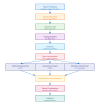Modern Management of Common Bile Duct Stones: Breakthroughs, Challenges, and Future Perspectives
- PMID: 39776736
- PMCID: PMC11703643
- DOI: 10.7759/cureus.75246
Modern Management of Common Bile Duct Stones: Breakthroughs, Challenges, and Future Perspectives
Abstract
Common bile duct (CBD) stone management has evolved significantly with technological advances and an improved understanding of pathophysiology. This comprehensive review examines current evidence and emerging trends in CBD stone management, emphasizing modern diagnostic approaches and treatment paradigms. Recent developments in imaging techniques, including AI-assisted analysis, have enhanced diagnostic accuracy. Treatment strategies now emphasize minimally invasive approaches, with endoscopic techniques showing success rates exceeding 90% in experienced centers. Special considerations for specific populations, including elderly patients and those with altered anatomy, have led to refined management algorithms. Future directions include novel stone fragmentation technologies, biodegradable materials, and personalized medicine approaches. The integration of these advances, combined with a multidisciplinary approach, has improved patient outcomes while presenting new opportunities for enhanced care delivery. Continued technological innovation and refined techniques suggest a promising future for CBD stone management, although challenges remain in optimizing treatment selection and preventing recurrence.
Keywords: biliary stone disease; choledocholithiasis; endoscopic retrograde cholangiopancreatography; laparoscopic common bile duct exploration; minimally invasive surgery; personalized medicine.
Copyright © 2024, Sha et al.
Conflict of interest statement
Conflicts of interest: In compliance with the ICMJE uniform disclosure form, all authors declare the following: Payment/services info: All authors have declared that no financial support was received from any organization for the submitted work. Financial relationships: All authors have declared that they have no financial relationships at present or within the previous three years with any organizations that might have an interest in the submitted work. Other relationships: All authors have declared that there are no other relationships or activities that could appear to have influenced the submitted work.
Figures

Similar articles
-
Advancements in Managing Choledocholithiasis and Acute Cholangitis in the Elderly: A Comprehensive Review.Cureus. 2025 Feb 4;17(2):e78492. doi: 10.7759/cureus.78492. eCollection 2025 Feb. Cureus. 2025. PMID: 40051943 Free PMC article. Review.
-
Laparoscopic transcystic duct common bile duct exploration.Surg Endosc. 2006 Apr;20 Suppl 2:S441-5. doi: 10.1007/s00464-006-0029-0. Epub 2006 Mar 16. Surg Endosc. 2006. PMID: 16544067 Review.
-
Comparison of laparoscopic common bile duct exploration plus cholecystectomy and endoscopic retrograde cholangiopancreatography followed by laparoscopic cholecystectomy for elderly patients with common bile duct stones and gallbladder stones.J Gastrointest Surg. 2024 May;28(5):719-724. doi: 10.1016/j.gassur.2024.02.026. Epub 2024 Mar 1. J Gastrointest Surg. 2024. PMID: 38503593
-
Comparing Stone Recurrence Following Surgical Common Bile Duct Exploration or Endoscopic Stone Extraction for Patients with Common Bile Duct Stones.J Laparoendosc Adv Surg Tech A. 2023 Apr;33(4):389-396. doi: 10.1089/lap.2022.0526. Epub 2023 Feb 3. J Laparoendosc Adv Surg Tech A. 2023. PMID: 36735566
-
One-stage versus two-stage management for acute cholecystitis associated with common bile duct stones: a retrospective cohort study.Surg Endosc. 2022 Feb;36(2):920-929. doi: 10.1007/s00464-021-08349-6. Epub 2021 Mar 31. Surg Endosc. 2022. PMID: 33788028
Cited by
-
Advancements in Managing Choledocholithiasis and Acute Cholangitis in the Elderly: A Comprehensive Review.Cureus. 2025 Feb 4;17(2):e78492. doi: 10.7759/cureus.78492. eCollection 2025 Feb. Cureus. 2025. PMID: 40051943 Free PMC article. Review.
-
Risk Factors for Common Bile Duct Stones in Patients with Previous Cholecystectomy: A Multicenter Prospective Proof-of-Concept Study.J Clin Med. 2025 Jun 26;14(13):4532. doi: 10.3390/jcm14134532. J Clin Med. 2025. PMID: 40648905 Free PMC article.
-
Laparoscopic micro-incision technique at cystic duct confluence for pediatric choledocholithiasis management: A case report.World J Gastrointest Surg. 2025 May 27;17(5):105894. doi: 10.4240/wjgs.v17.i5.105894. World J Gastrointest Surg. 2025. PMID: 40502507 Free PMC article.
References
-
- Updated guideline on the management of common bile duct stones (CBDS) Williams E, Beckingham I, El Sayed G, Gurusamy K, Sturgess R, Webster G, Young T. Gut. 2017;66:765–782. - PubMed
-
- Unchanged mortality in patients with acute cholangitis despite an increase in malignant etiologies - a 25-year epidemiological study. Tan M, Schaffalitzky de Muckadell OB, Laursen SB. Scand J Gastroenterol. 2019;54:335–341. - PubMed
Publication types
LinkOut - more resources
Full Text Sources
